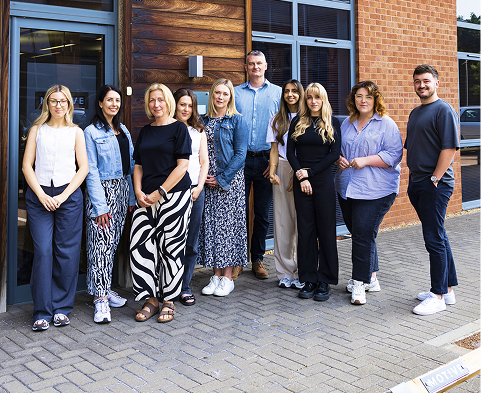Backlinks remain one of the most important ranking factors for SEO - even in 2025. While Google has downplayed their influence compared to the past, they’re still a vital part of any effective SEO strategy.

That’s because links signal to search engines that your content is credible, authoritative, and worth referencing - all of which play a big part in helping your site climb the search rankings and attract more organic traffic. But how you earn those links matters.
The traditional approach is “active” link building. Reaching out to websites, pitching your content, or guest posting. And while this technique is really effective, it can be resource-heavy and time consuming, especially if you don’t have a digital PR agency doing the work for you.
So, what if you could earn backlinks without pitching at all? It almost sounds too good to be true, doesn’t it? Well, that’s where passive link building comes in. Instead of chasing links, the aim is to create content and assets that naturally attract them over time.
Okay, we’re making it sound way too simple, as a lot more work goes into this approach than simply creating content and automatically earning links until the end of time. But fortunately for you, this blog will break down what passive link building is, why it matters, and how you can make it work for your brand.
What’s in this article:
- What is passive link building?
- Why does passive link building matter?
- Passive link building in action (examples)
- How to do passive link building
- Challenges of passive link building
- Key takeaways
What is passive link building?
Simply put, passive link building is a strategy designed to naturally acquire backlinks without the need for constant outreach. Instead of pitching, guest posting, or cold emailing, you focus on creating content so valuable that others will want to link to it on their own without even being asked.
.jpg)
But don’t mistake “passive” for “effortless”. It’s far from effortless. Passive can be a misleading term in SEO. To be successful in this approach, you’ll need to put in some hard work too. Upfront work is required, and this includes careful topic research, skilled writing, smart formatting, and actually creating your useful assets. As PR Posting neatly puts it: “You’re not passive. You’re working upfront, so others link later.”
There are particular types of content that work best for this type of approach, including data-led articles, interactive tools, and highly sharable visuals. These are all resources that provide lasting value and continue attracting links long after they’re published.
So compared to active link building, where you’re hands-on with pitching and relationship building, passive link building is more of a long-term play, and you’ll need to have patience. You may sacrifice some control - since you can’t target or request links directly - but you gain authority and natural, editorial backlinks that signal real trust.
In practice, the best digital PR and SEO strategies combine both approaches. Active digital PR campaigns help you gain links quickly and at scale, while passive link building creates evergreen assets that earn links in the background, often for years to come.
Why does passive link building matter?
As we mentioned at the end of the last section, most SEO strategies work best with a blend of passive and active link building tactics. But there are some clear reasons why passive link building deserves a place in your strategy, from the SEO benefits it brings to the authority it builds for your sites.
Backlinks remain one of Google’s strongest ranking signals, even if their importance has lessened over time. Quality matters most. High quality links from relevant and reputable sites are still going to carry some weight, while links that have been paid for or manipulated will risk being penalised. Google dislikes spam. A lot.
The good news is, this is where passive link building stands out. Links are editorially given. They are earned through strong content, useful resources, or your brand's reputation. They’re considered more trustworthy and valuable. Search engines see them as a genuine signal of credibility. And beyond SEO, those natural links from journalists, bloggers, and industry peers enhance your brand reputation and position you as a trusted source.
And another big advantage is future-proofing. As Google continues to clamp down on manipulative link tactics, passive link building actually aligns with Google’s E-E-A-T principles (Expertise, Experience, Authoritativeness, Trustworthiness), making it a safer, longer-term strategy.
Finally, there’s the ROI. Active campaigns can be resource-heavy and time consuming, while passive strategies scale over time. Once you’ve invested in creating link-worthy assets, they can continue to naturally attract links, with little extra effort, for years to come.
In short, passive link building matters, and it can deliver sustainable SEO value for you. It helps you attract high-quality backlinks that boost rankings, build authority, and stand the test of time - all while scaling far more efficiently than constant outreach. What’s not to love?
Passive link building in action (examples)
From original data studies, to evergreen guides, tools, and visual assets, certain types of content are particularly effective at earning links because they provide value that journalists and bloggers can’t easily replicate. Here are some of the best-performing examples:
.jpg)
Data-led studies and research
Data-led studies and research naturally attract links because bloggers and journalists naturally cite and link to credible, original sources when covering a topic. Examples include annual industry reports, consumer or market surveys, and regional data studies.
A standout example is BuzzStream’s ‘State of Digital PR Report (2025)’, packed full of original, useful statistics - and one I’ve personally cited multiple times in my own blogs. Another is Rightmove’s annual ‘Happy at Home’ survey, now in its 13th year. This regional study identifies the happiest places to live in the UK and consistently earns links from local news outlets and blogs.
Interactive tools and calculators
Interactive tools and calculators are powerful passive link assets because they solve real problems and are easy to use. When designed well, they attract links naturally from journalists or bloggers covering related topics.
Examples include MoneySavingExpert’s mortgage calculator and IIFYM’s calorie calculator. Both of these tools are highly user-friendly, help to solve a real life problem for the user, and as a result, both have been widely cited in finance and fitness articles over the years.
Evergreen guides
Evergreen guides remain relevant year after year, making them a classic passive link building method. ‘How To’ guides, for example, answer recurring questions and attract consistent links over time. A good example in SEO is Ahrefs’ ‘How to do Keyword Research for SEO’.
Ultimate resource guides are another effective form, consolidating useful information into one place so readers and other sites can reference them easily. A simple, highly effective example is Smarter Traveller’s ‘Ultimate Packing List’. Bonus points for it being interactive too.
Visual assets
High-quality visual content - such as infographics, charts, maps, custom images, and videos - are highly sharable and easier for audiences to digest.
Visual Capitalist produces excellent data-driven infographics covering topics like the economy, healthcare, and technology, while Our World in Data offers a range of interactive charts and maps that are cited widely by journalists and cover numerous global issues. For visually creative assets, Information is Beautiful specialises at turning complex information into engaging, widely shared infographics in an aesthetically pleasing way.
How to do passive link building
Passive link building is about creating content that will naturally earn backlinks to your site over time. It’s a sustainable strategy that helps to build authority and has long-term SEO value, all without heavy, ongoing outreach. Here’s a step-by-step approach:
Identify evergreen topics
Start by pinpointing the topics that interest your audience and have long-term relevance. Ask yourself, “will this still matter in X years time?” If the answer is “probably”, then it’s worth creating content around.
Use tools like Ahrefs Keyword Explorer to find relevant terms with a steady search volume and low-to-moderate competition. As BuzzStream notes, it’s also important to check if top-ranking posts are actually getting links over time. Just because search volume exists for a keyword doesn’t always mean writers and researchers cite it in their posts.
Keyword research should be complemented with a competitor analysis. This way, you can see which pages in your niche are considered ‘link-worthy’, and aim to create something even better or more comprehensive.
Create link-worthy content assets
Once you’ve identified topics, it’s time to produce high-quality assets that will earn backlinks long after publishing. This could include data-led studies, interactive tools and calculators, or strong visual assets like infographics, charts and videos.
Ask yourself, “would a journalist or blogger find this resource helpful? Would I link to this content myself?” The more unique and insightful your content is, the more likely it is to attract passive links.
Optimise for visibility
Even the best content can go unnoticed if it isn’t easy to find, so you’ll need to ensure you’re optimising for greater visibility. The best SEO practices need to be applied. Use descriptive, keyword-focused titles, optimise meta tags, structure content with clear headings, and add schema markup to enhance search visibility.
Lyssna’s blog covers the best practices to achieve a balance between SEO and UX for better visibility and engagement.
Promote content initially
Passive link building eventually relies on organic attention and little outreach on your part, but content still requires an initial push. Share your content across your social channels, email newsletters, and relevant online communities. Consider reaching out to journalists or bloggers who cover similar topics, making them aware that you have a high-quality resource available. Outreach at this stage doesn’t have to be aggressive, the goal is to ensure your content reaches the people most likely to share it.
Monitor and refresh content
Evergreen content continues earning links when it stays relevant. Use analytics and SEO tools to monitor performance and identify any pages that have declining traffic or outdated information. Update stats and insights, and refresh content rather than creating something entirely new. Annual reports, like the ‘State of Digital PR Report (2025)’, are perfect examples of content that benefits from regular updates.
Make attribution easy
Finally, you’ll need to simplify the linking process. This includes having clear citations, embed codes for visual content like infographics or charts, and where possible, provide downloadable assets. The easier you make it for someone to republish or reference your content, the more likely they are to link back to your site.
Challenges of passive link building
While passive link building is a powerful SEO tool, it’s not without its challenges. The first hurdle to overcome is simply getting noticed. The internet is flooded with content, so if you want to earn backlinks organically with little outreach efforts, you need to be offering something genuinely insightful and useful to stand out in the crowd.
And remember, “passive” doesn’t mean “instant”. Creating link-worthy assets is a long term investment. Unlike traditional outreach campaigns that might deliver quicker wins, passive link building takes time to gain traction.
You also can’t rely on the “build it and they will come” mindset. Even the best resources need that initial push to gain momentum. The goal is to earn links naturally over time, but content still requires promotion to get noticed.
But with all that said, the pay off is worth it. Once you’ve built a bank of high-value, link-worthy assets, they continue working in the background, attracting backlinks and authority long after the initial effort.
Key takeaways
- Passive link building is a long-term strategy. Focus on creating high-quality, valuable content that naturally earns backlinks over time, rather than relying solely on outreach.
- Content type matters. Data-led studies, interactive tools, evergreen guides, and visual assets are particularly effective at attracting editorial links.
- Combine passive and active approaches. Use passive strategies to build evergreen assets and active tactics for targeted link acquisition to maximise SEO impact.
- Optimisation and promotion are essential. Even link-worthy content needs SEO optimisation, initial promotion, and visibility efforts to gain traction.
- Monitor, refresh, and make linking easy. Keep content up to date, provide clear citations or embed codes, and simplify sharing to maximise the long-term value of your assets.
Get in touch with us today to start creating link-worthy content that naturally earns authority and boosts your SEO.



.jpg)

.jpg)
.jpg)


.jpg)

